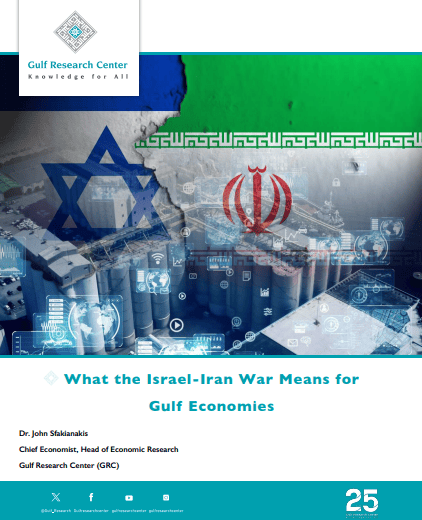
The recent outbreak of hostilities between Israel and Iran marks a dangerous escalation in a region already shaped by overlapping rivalries and shifting alliances. While much of the world watches with concern for the military and humanitarian consequences, Gulf economies—particularly those of Saudi Arabia, the United Arab Emirates, and Qatar—find themselves navigating a rapidly changing strategic and energy landscape. In the short to medium term, the Israel-Iran war poses both opportunities and risks for these states, especially with regard to oil prices, regional investment flows, and their long-term economic diversification agendas.
Despite vocal concern about Iranian reprisals against Gulf oil infrastructure, there is a widespread belief among analysts and regional officials that a direct Iranian strike on Gulf assets remains unlikely. The Gulf Arab monarchies are not party to the war, and Tehran has little incentive to provoke U.S. military retaliation by attacking third-party oil installations. Thus, while risk premiums may rise, the immediate threat to production capacity in places like Abqaiq or Ras Tanura remains limited. For now.
Yet even without direct targeting, the war’s broader implications for energy markets are already being felt. Iran’s oil exports—once partially rehabilitated under quiet diplomacy with China and through loopholes in enforcement—now face renewed pressure. A full-scale conflict could prompt the United States to tighten sanctions enforcement, effectively cutting Iranian barrels from global markets. That would constrict global supply, drive prices higher, and create breathing room for Gulf producers.
For Saudi Arabia, this scenario presents a geopolitical paradox. While Riyadh has long viewed Iran’s regional ambitions with deep suspicion, a prolonged conflict that sidelines Iranian production allows Saudi Arabia to reassert itself in key markets, especially in Asia. In recent years, Iranian crude—often sold at discounts to Chinese refiners—has eroded Saudi market share in the world’s largest oil-importing country. A supply disruption in Iran could reverse that trend, bolstering Aramco’s position and supporting prices without requiring formal OPEC+ cuts. However, the situation is more complex than it appears. The global oil market has shown signs of surplus rather than scarcity. In the months leading up to the Israel-Iran conflict, oil inventories were consistently exceeding typical seasonal levels—an unmistakable sign of an oversupplied market. Although there has been significant discourse suggesting a tight market, underlying fundamentals suggest otherwise. As a result, any geopolitical-driven price surge may be short-lived, tempered by elevated stockpiles, weakerthan-expected demand—particularly from China—and the capacity of other producers, notably U.S. shale firms, to ramp up output rapidly.
Budgets across the region remain heavily oil-dependent, despite diversification efforts. Higher oil prices would offer windfall revenues that can support domestic megaprojects, social spending, and sovereign wealth fund investments. For a region still reeling from the oil price volatility of 2020-21, this fiscal cushion is welcome. But such windfalls are not without cost—or risk.
First, volatility is a double-edged sword. While higher prices support short-term revenues, they complicate long-term planning and discourage structural reform. Policymakers may delay painful but necessary measures—such as subsidy rationalization, tax reform, or civil service restructuring—in favour of populist spending. This risks deepening the Gulf’s dependency on oil rather than accelerating its transition away from it.
Second, the conflict complicates the Gulf’s ambitions to position themselves as stable, neutral platforms for global capital. Dubai, Abu Dhabi, and Riyadh have all sought to become regional business hubs, luring multinationals, tech firms, and financiers with promises of geopolitical insulation and regulatory certainty. A destabilized Middle East—especially one marked by open war between Iran and Israel—undermines this narrative. Risk premiums rise, investment decisions are delayed, and the region’s reputational allure fades.
Third, the conflict reshapes energy transition dynamics. Elevated oil prices may embolden petrostates and delay decarbonization momentum, but they also accelerate the drive in consuming nations to diversify energy sources. Europe’s post-Ukraine pivot away from Russian hydrocarbons has already triggered massive investments in renewables, hydrogen, and LNG import capacity. A prolonged Middle East conflict would reinforce these trends, increasing long-term demand uncertainty for Gulf oil.
Moreover, Gulf states are not immune to domestic pressure. Gulf leaders will need to calibrate their foreign policy postures carefully—projecting strength without appearing provocative, maintaining neutrality while preparing for worst-case scenarios.
The energy markets, meanwhile, are already pricing in geopolitical risk. Brent crude briefly spiked on news of the initial Israeli Iranian exchanges and may rise further if shipping through the Strait of Hormuz is disrupted. Nearly one-fifth of the world’s oil passes through this vital chokepoint. Any perceived threat to its security— whether through drone strikes, naval incidents, or cyberattacks—would amplify volatility and spark global concern. Insurance premiums for tankers have already risen, and longer shipping routes could inflate costs.
At the same time, OPEC+ finds itself in a complex bind. If prices rise too sharply, it may trigger demand destruction or draw political backlash in consumer countries. But if prices remain subdued, producer states risk undercutting their budgets. Saudi Arabia, its de facto leader, will need to navigate this carefully balancing fiscal needs, geopolitical loyalties, and global economic realities.
In the end, the Israel-Iran war underscores a central truth: the Gulf remains tied to the fate of its neighbourhood, no matter how much it invests in post-oil futures or global prestige. While the conflict may yield short-term economic gains through higher oil prices and market share, it also threatens to reinsert instability into the heart of a region striving for reinvention.
The Gulf remains tied to the fate of its neighbourhood, no matter how much it invests in post-oil futures or global prestige. While the conflict may yield short-term economic gains through higher oil prices and market share, it also threatens to reinsert instability into the heart of a region striving for reinvention
Chief Economist, Head of Economic Research Gulf Research Center (GRC)

